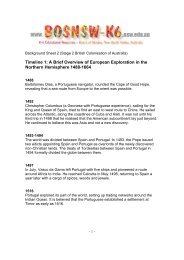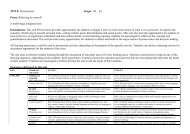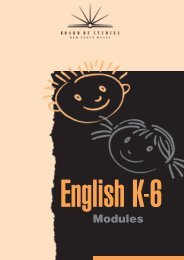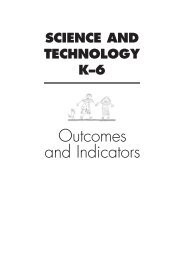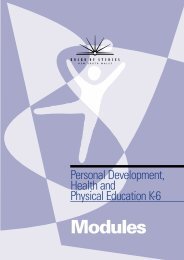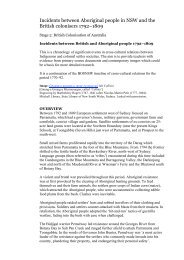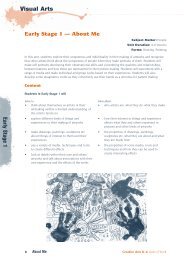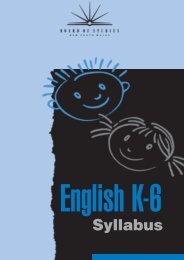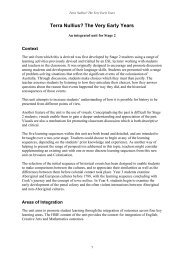Math K-6 WS - K-6 Educational Resources
Math K-6 WS - K-6 Educational Resources
Math K-6 WS - K-6 Educational Resources
You also want an ePaper? Increase the reach of your titles
YUMPU automatically turns print PDFs into web optimized ePapers that Google loves.
<strong>Math</strong>ematicsK-6 Early Stage1<br />
Using 5 as a Reference<br />
Part A<br />
Students are given an egg carton that has been cut to form<br />
two rows of five. Five chicks are placed in the top row and the<br />
students use this as a reference for counting numbers up to<br />
10. Students are asked to count numbers up to 10 by placing<br />
some chicks in the bottom row of the egg carton. Students<br />
compare their arrangements of chicks.<br />
Possible questions include:<br />
❚ what is the number you have now?<br />
❚ what is the next number?<br />
❚ how did you count it?<br />
Part B<br />
The teacher uses two joined egg cartons to create two rows of<br />
10. Students count beads, buttons or shells into the egg<br />
cartons to show ten, ten and one, ten and two, etc. (Starting<br />
from 10 should be emphasised.)<br />
Counting into Cups<br />
In small groups, students are given containers such as paper<br />
cups, each labelled with a number 0 to 10, (then 0 to 20, 0 to<br />
30). Students are asked to identify the number on the cup and<br />
count the corresponding number of popsticks in the cup, and<br />
place them in order.<br />
Computer Numbers<br />
In pairs, students use simple computer graphics to represent<br />
the numbers 0 to 20. Students are encouraged to discuss how<br />
best to arrange the graphics so that each number can be<br />
identified quickly.<br />
Race to 10 or 20<br />
Sample Units of Work<br />
In pairs, students are each given a set of consecutive number<br />
cards eg 0 to 10 or 0 to 20. They shuffle their cards and place<br />
them face down. On ‘Go’ students race to order their cards,<br />
placing them face up.<br />
Variation: The cards are ordered backwards 10 to 0, then 20<br />
to 10.<br />
Possible questions include:<br />
❚ can you read and order the numbers?<br />
❚ from 12, can you count forwards to 30?<br />
❚ can you count backwards from 19 to 0?<br />
(Adapted from CMIT)<br />
14<br />
WM<br />
Calculator<br />
In groups, students display a number eg 2 on their calculator.<br />
They use the ‘Clear’ button to clear the display. This is repeated<br />
for other numbers in the range 0 to 9. Students then make<br />
their displayed number from popsticks or similar materials and<br />
glue them onto the page. Students then order their popstick<br />
numbers with the other numbers made in the group.<br />
Extension: Students display numbers in the range 10 to 19, 20 to 29.<br />
How Many Dots?<br />
The numbers 0 to 10, represented by dots on transparent tenframes<br />
are required for this activity<br />
eg<br />
One frame is selected by the teacher and briefly displayed on<br />
an overhead projector.<br />
The students determine and record how many dots are on the<br />
ten-frame.<br />
The teacher asks the students ‘How did you work out how<br />
many dots there were?’<br />
Extension: Two ten-frames are placed on the overhead<br />
projector at a time. Students are asked to find the total number<br />
of dots and describe their strategies. (Adapted from CMIT)<br />
WM<br />
Where’s the Number?<br />
Each student is provided with a strip of cardboard that<br />
represents a number line, with zero written at one end and<br />
ten written at the other.<br />
Using a peg as a marker, the students are asked to locate a<br />
particular number on the number line and discuss its<br />
0 10<br />
placement in relation to 0 and 10.<br />
The activity is repeated for other numbers between 0 and 10<br />
eg move the peg to where the number 9 would be.<br />
Extension: The activity could be extended using a 0 to 20<br />
number line. (Adapted from CMIT)



